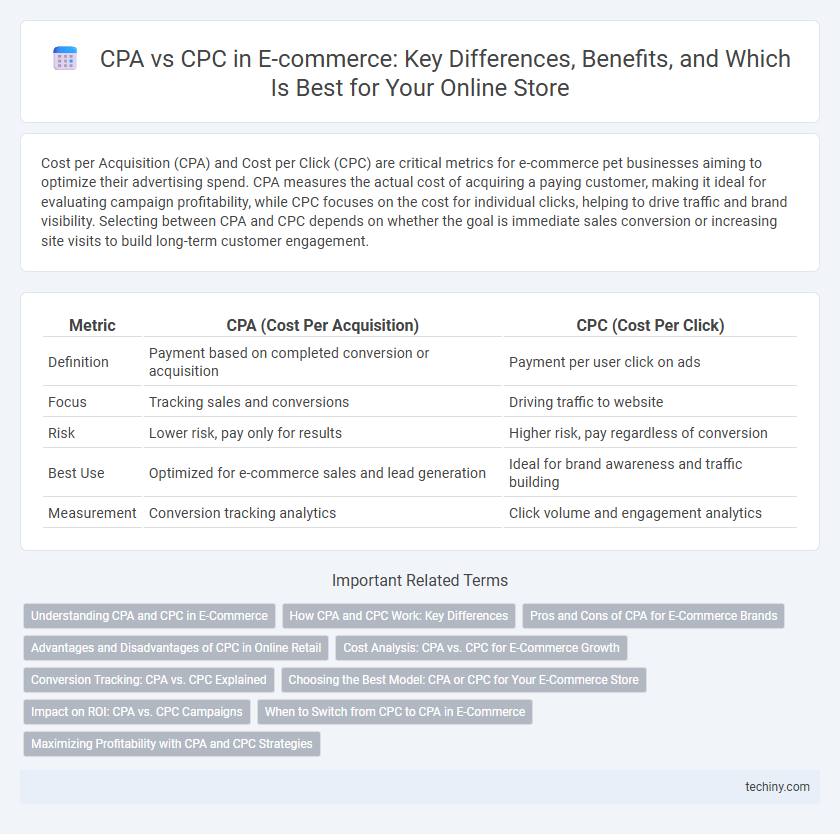Cost per Acquisition (CPA) and Cost per Click (CPC) are critical metrics for e-commerce pet businesses aiming to optimize their advertising spend. CPA measures the actual cost of acquiring a paying customer, making it ideal for evaluating campaign profitability, while CPC focuses on the cost for individual clicks, helping to drive traffic and brand visibility. Selecting between CPA and CPC depends on whether the goal is immediate sales conversion or increasing site visits to build long-term customer engagement.
Table of Comparison
| Metric | CPA (Cost Per Acquisition) | CPC (Cost Per Click) |
|---|---|---|
| Definition | Payment based on completed conversion or acquisition | Payment per user click on ads |
| Focus | Tracking sales and conversions | Driving traffic to website |
| Risk | Lower risk, pay only for results | Higher risk, pay regardless of conversion |
| Best Use | Optimized for e-commerce sales and lead generation | Ideal for brand awareness and traffic building |
| Measurement | Conversion tracking analytics | Click volume and engagement analytics |
Understanding CPA and CPC in E-Commerce
Cost Per Acquisition (CPA) in e-commerce measures the expense incurred to secure a customer purchase, optimizing marketing spend directly tied to sales conversions. Cost Per Click (CPC) focuses on the cost paid for each user click on an advertisement, driving traffic to online stores but not guaranteeing immediate sales. Analyzing CPA versus CPC helps e-commerce businesses allocate budgets effectively by balancing traffic generation and actual customer acquisition.
How CPA and CPC Work: Key Differences
CPA (Cost Per Acquisition) charges advertisers only when a specific action, such as a sale or lead, is completed, ensuring direct ROI tracking and performance-based spending. CPC (Cost Per Click) requires payment each time a user clicks on an ad, prioritizing traffic generation but without guaranteeing conversions. Understanding these differences helps e-commerce businesses optimize budgets by aligning goals with either acquisition-focused CPA or traffic-driven CPC models.
Pros and Cons of CPA for E-Commerce Brands
Cost-Per-Acquisition (CPA) advertising offers e-commerce brands predictable expenses tied directly to successful conversions, minimizing wasted ad spend and improving return on investment. However, CPA models can lead to higher upfront costs and may limit traffic volume, as advertisers only pay for completed actions rather than clicks or impressions. Brands must balance CPA's efficiency in driving sales with the potential restriction on audience reach compared to Cost-Per-Click (CPC) campaigns.
Advantages and Disadvantages of CPC in Online Retail
Cost-per-click (CPC) advertising in online retail offers precise budget control and immediate traffic generation by charging only when users click ads, making it ideal for driving targeted visits and testing campaign effectiveness. However, CPC carries the risk of attracting non-converting clicks, potentially inflating marketing expenses without guaranteed sales, which can reduce overall return on investment (ROI). The model demands continuous optimization, including keyword management and bid adjustments, to maximize conversions and avoid wasted spend in competitive markets.
Cost Analysis: CPA vs. CPC for E-Commerce Growth
CPA (Cost Per Acquisition) focuses on paying only when a customer completes a purchase, making it a cost-effective model for e-commerce businesses aiming for direct sales. CPC (Cost Per Click) charges for every click on an ad, which can drive traffic but may lead to higher costs without guaranteed conversions. Analyzing CPA versus CPC helps e-commerce brands optimize advertising budgets by balancing immediate traffic acquisition with long-term customer acquisition costs.
Conversion Tracking: CPA vs. CPC Explained
Conversion tracking in e-commerce distinguishes CPA (Cost Per Acquisition) and CPC (Cost Per Click) by measuring different user actions; CPA tracks the actual purchase or lead completion, providing direct insight into ROI, while CPC monitors clicks that drive traffic without guaranteeing conversions. CPA campaigns optimize for specific outcomes, enabling businesses to allocate budget efficiently towards actions that generate revenue. In contrast, CPC serves as a foundation for awareness and engagement metrics, requiring additional analysis to assess true conversion performance.
Choosing the Best Model: CPA or CPC for Your E-Commerce Store
Choosing between CPA (Cost Per Acquisition) and CPC (Cost Per Click) models depends on your e-commerce store's specific goals and budget. CPA is ideal for businesses seeking measurable sales conversions and a clear return on ad spend, as costs are incurred only when a purchase or desired action occurs. CPC works well for driving traffic and brand awareness, but may lead to higher costs without guaranteed sales, so optimizing campaigns for targeted clicks is essential.
Impact on ROI: CPA vs. CPC Campaigns
CPA campaigns directly link ad spend to conversions, ensuring a clear impact on ROI by paying only for successful actions. CPC campaigns, while offering more traffic, can lead to variable ROI due to paying for clicks regardless of conversion outcomes. Choosing CPA over CPC often results in more efficient budget allocation and higher overall return on investment.
When to Switch from CPC to CPA in E-Commerce
Switching from CPC to CPA in e-commerce becomes advantageous when conversion tracking is accurately set up and profit margins allow for performance-based spending. CPA models optimize ad spend by focusing on actual sales or leads, ensuring better ROI compared to CPC's click-based payments. Businesses experiencing stable traffic with varying conversion rates benefit from CPA to enhance budget efficiency and scale customer acquisition effectively.
Maximizing Profitability with CPA and CPC Strategies
Maximizing profitability in e-commerce requires a strategic balance between CPA (Cost Per Acquisition) and CPC (Cost Per Click) models, where CPA ensures payment only for actual conversions, reducing wasted ad spend. Leveraging CPC campaigns can drive high traffic volumes and improve brand visibility while carefully optimized targeting and bidding controls keep costs aligned with return on ad spend (ROAS). Integrating data analytics and real-time performance tracking enhances decision-making, allowing advertisers to allocate budget efficiently between CPA and CPC based on campaign goals and customer acquisition costs.
CPA vs CPC Infographic

 techiny.com
techiny.com